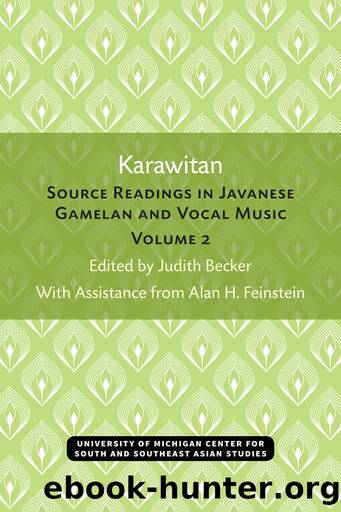Karawitan: Source Readings in Javanese Gamelan and Vocal Music by Judith Becker

Author:Judith Becker
Language: eng
Format: epub
Publisher: University of Michigan Center for South and Southeast Asian Studies
Published: 2020-02-15T00:00:00+00:00
Signed,
Prajapangrawit
Notes
TRANSLATORâS NOTES
1Several words were incorrectly transliterated or omitted from this passage in both Latin-alphabet editions of Wédha Pradangga. This was brought to my attention by Marc Perlman (personal communication; see Wédha Pradangga, volume 1, note 1), who transliterated this passage from the original Javanese-script manuscript, as follows. (Words incorrectly transliterated or omitted from the Latin-alphabet editions are italicized.)
. . . dalah gendhing monca utawi pasisir inggih kacakup. Kathak pakempalan tabuhan / utawi sinau nabuh gangsa . . .
The second and third paragraphs of volume 6, âSampéyan Dalem Ingkang . . . thereby increasing the glory of the kraton,â appear only in the first Latin-alphabet edition of Wédha Pradangga.
2The names of the medals given here and below are in Dutch, although the spelling is Javanese. For more information about these medals, see Werlich (1974, 54-57, 323-27), and Grote Winkler Prins: Encyclopedic in Twintig Deel (1972, 14:667-70).
3When the number of ranks below kliwon were reduced from seven to five, officials with the rank panèket in the old system probably were given the rank mantri in the new system. During the transitional period, references to officials included both old and new ranks (see âTranslatorâs Introductionâ). The âumbrella rank of mantriâ (songsong mantri) refers to the practice of distinguishing ranks by the color of the umbrella an official was permitted to use. Petty officials such as panèket were permitted the dark umbrella, while higher officials such as mantri were permitted the red umbrella (Raffles 1965, 2:312).
4In 1935, Radèn Ngabèhi Prajapangrawit was in the corresponding rank on the left side, musician with the rank panèwu.
5The manuscript reads â... dipun biyantu Kiyai Demang. Akaliyan M.L. Purwopang-rawit, (M.Ng. Purwopangrawit) dipun biyantu Kiyai Demang Gunopangrawitâ [âHe was assisted by Kyai Demang and by M.L. Purwapangrawit (M.Ng. Purwapangrawit), assisted by Kyai Demang Gunapangrawitâ]. Since âKiyai Demangâ is not a complete name, and âdipun biyantuâ is unnecessarily repeated, it is likely that the typist intended this passage to read â... dipun biyantu Kiyai Demang Gunopangrawit, akaliyan M.L. Purwopangrawit (M.Ng. Purwopangrawit).â The first edition of Wédha Pradangga identifies Kyai Demang Gunapangrawit as Radèn Riya Ngabèhi Gunapangrawit.
6In the text the Javanese year is written 1842, but the year Ãhé 1852 A.J. corresponds to May 1922 (Encyclopaedic van Nederlandsch Indië, 1917-40, 5:415).
7In the text the Javanese year is written 1844, but the twenty-eighth day of Besar in the year Jé corresponds to July 31, 1924 (ibid.).
8The tumbuk is a ceremony celebrating birthdays at eight-year intervals: at the eighth year, the sixteenth, the twenty-fourth, and so on. These eight-year periods are called windu. (The âyearâ referred to here is not the Christian year, but the Javanese year of 210 days.)
9For an explanation of the Tuesday- and Wednesday-letter calendars, see the âTranslatorâs Introduction.â
10See note 3, above.
11See note 3, above. Also see âTranslatorâs Introduction.â
12Evidently there are three people named Mas Lurah Prawiramlaya: this one, the person mentioned in the next paragraph, and a third individual, who is mentioned at various places in the text. At one point these three are listed together, indicating that they are in fact separate individuals (see page 157).
Download
This site does not store any files on its server. We only index and link to content provided by other sites. Please contact the content providers to delete copyright contents if any and email us, we'll remove relevant links or contents immediately.
The Goal (Off-Campus #4) by Elle Kennedy(12424)
Kathy Andrews Collection by Kathy Andrews(10507)
Diary of a Player by Brad Paisley(6864)
What Does This Button Do? by Bruce Dickinson(5521)
Assassin’s Fate by Robin Hobb(5229)
Big Little Lies by Liane Moriarty(4876)
Pale Blue Dot by Carl Sagan(3996)
Sticky Fingers by Joe Hagan(3449)
The Heroin Diaries by Nikki Sixx(2928)
The Death of the Heart by Elizabeth Bowen(2896)
Beneath These Shadows by Meghan March(2714)
The Help by Kathryn Stockett(2700)
Confessions of a Video Vixen by Karrine Steffans(2669)
How Music Works by David Byrne(2521)
Jam by Jam (epub)(2481)
Harry Potter 4 - Harry Potter and The Goblet of Fire by J.K.Rowling(2413)
Strange Fascination: David Bowie: The Definitive Story by David Buckley(2364)
Petty: The Biography by Warren Zanes(2234)
Darker Than the Deepest Sea by Trevor Dann(2205)
